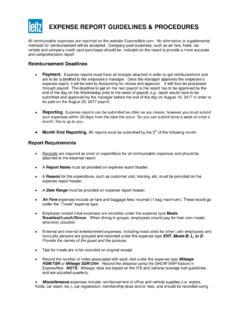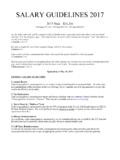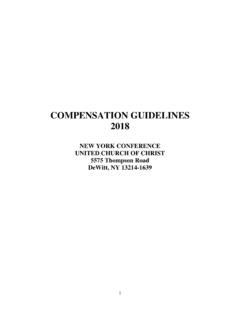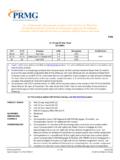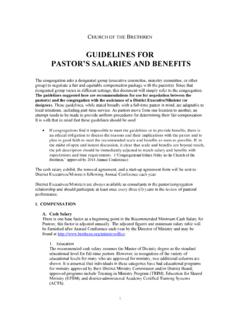Transcription of Publication 598 (Rev. January 2017) - irs.gov
1 1. Organizations Subject to the 2. The Tax and Filing 3. Unrelated Trade or 4. Unrelated Business Taxable DevelopmentsThe IRS has created a page on for information about Pub. 598, at Information about any future developments affecting Pub. 598 (such as legislation enacted after we release it) will be posted on that 's NewThe maximum cost of a low-cost article, for organizations eligible to receive charitable contributions, was increased to $ for 2016. See Distribution of low-cost articles, annual limit on associate member dues received by an agricultural or horticultural organization not treated as gross income was increased to $161 for 2016. See Exception under Dues of Agricultural Organizations and Business Leagues of special rule for contributions of capital gain real property made for conservation purposes has been made permanently tax deductible for payments received or accrued after December 31, 2015.
2 You can claim the contribution of capital gain real property made for conservation purposes that occurred after December 31, 2015, on Form 990-T. See Suspension of deduction limits for farmers and exclusion from unrelated business taxable income for qualifying specified payments under section 512(b)(13)(E) has been permanently extended for payments received or accrued after December 31, 2014. You can claim the qualifying specified payments that occurred after December 31, 2014, on Form 990-T. See Excess qualifying specified a private delivery service is used, only deliver Form 990-T to:Internal RevenueSubmission Processing Center1973 North Rulon White , UT 84201-0027 Department of the TreasuryInternal Revenue ServicePublication 598(Rev. January 2017) Cat. No. 46598 XTax on Unrelated Business Income of Exempt OrganizationsGet forms and other information faster and easier at: (English) (Espa ol) ( ) ( ) (Pусский) (Ti ngVi t) Userid: CPMS chema: tipxLeadpct: 100%Pt.
3 Size: 8 Draft Ok to PrintAH XSL/XMLF ileid: .. ons/P598/201701/A/XML/Cycle01/source(Ini t. & Date) _____Page 1 of 22 21:27 - 26-Dec-2016 The type and rule above prints on all proofs including departmental reproduction proofs. MUST be removed before 26, 2016 IntroductionAn exempt organization isn t taxed on its in-come from an activity substantially related to the charitable, educational, or other purpose that is the basis for the organization's exemp-tion. Such income is exempt even if the activity is a trade or , if an exempt organization regu-larly carries on a trade or business not substan-tially related to its exempt purpose, except that it provides funds to carry out that purpose, the organization is subject to tax on its income from that unrelated trade or Publication covers the rules for the tax on unrelated business income of exempt organ-izations.
4 It organizations are subject to the tax (chapter 1), the requirements are for filing a tax return (chapter 2), an unrelated trade or business is (chapter 3), to figure unrelated business taxable income (chapter 4).All section references in this Publication are to the Internal Revenue ItemsYou may want to see:PublicationTax-Exempt Status for Your OrganizationForm (and Instructions)Exempt Organization Business Income Tax ReturnSee chapter 5 for information about getting these publications and and suggestions. We welcome your comments about this Publication and your suggestions for future can send your comments from Click on "More Infor-mation" and then on "Give us feedback." Or you can write to:Internal Revenue ServiceTax Forms and Publications1111 Constitution Ave. NW, IR-6526 Washington, DC 20224We respond to many letters by telephone.
5 Therefore, it would be helpful if you would in-clude your daytime phone number, including the area code, in your we can t respond individually to each comment received, we do appreciate your feedback and will consider your comments as we revise our tax products. 557 990-T Subject to the TaxThe tax on unrelated business income applies to most organizations exempt from tax under section 501(a). These organizations include charitable, religious, scientific, and other organi-zations described in section 501(c), as well as employees' trusts forming part of pension, profit-sharing, and stock bonus plans described in section 401(a).In addition, the following are subject to the tax on unrelated business retirement arrangements (IRAs), including traditional IRAs, Roth IRAs, sim-plified employee pensions (SEP-IRAs), and savings incentive match plans for em-ployees (SIMPLE IRAs).
6 State and municipal colleges and state tuition savings accounts (MSAs) descri-bed in section 220(d).Coverdell savings accounts described in section instrumentalities. A corporation that is a instrumentality described in section 501(c)(1) isn t subject to the tax on unrelated business income if the corporation is organized under an Act of Congress and, under the Act, is exempt from federal income and universities. Colleges and uni-versities that are agencies or instrumentalities of any government or any political subdivision of a government, or that are owned or operated by a government or political subdivision of a government, are subject to the tax on unrelated business income. As used here, the word gov-ernment includes any foreign government (to the extent not contrary to a treaty) and all do-mestic governments (the United States and any of its possessions, any state, and the District of Columbia).
7 The tax is on the unrelated business income of both the universities and colleges themselves and on their wholly owned or controlled tax ex-empt subsidiary organizations. It is immaterial whether the business is conducted by the uni-versity or by a separately incorporated wholly owned or controlled subsidiary. If the business activity is unrelated, the income in both instan-ces will be subject to the tax. If the primary pur-pose of a wholly owned or controlled subsidiary is to operate or conduct any unrelated trade or business (other than holding title to property and collecting income from it), the subsidiary isn t an exempt organization, and this rule doesn t corporations. When an exempt title-holding corporation, described in section 501(c)(2), pays any of its net income to an or-ganization that itself is exempt from tax under section 501(a) (or would pay such an amount except that the expenses of collecting its in-come exceed the amount collected) and files a consolidated return with that organization, the title-holding corporation is treated, for unrelated business income tax purposes, as organized and operated for the same purposes as the ex-empt payee , a title-holding corporation whose source of income is related to the exempt pur-poses of the payee organization isn t subject to the unrelated business income tax if the holding corporation and the payee organization file a consolidated return.
8 However, if the source of the income isn t so related , the title-holding cor-poration is subject to unrelated business in-come X, a title-holding corporation, is required to distribute its net income to A, an ex-empt organization. During the tax year, X real-izes net income of $900,000 from source M, which is related to A's exempt function. X also receives $100,000 from source N, which isn t related to A's exempt function. X and A file a consolidated return for the tax year. X has unre-lated business income of $100, Tax and Filing RequirementsAll organizations subject to the tax on unrelated business income, except the exempt trusts de-scribed in section 511(b)(2), are taxable at cor-porate rates on that income. All exempt trusts subject to the tax on unrelated business income that, if not exempt, would be taxable as trusts are taxable at trust rates on that income.
9 How-ever, an exempt trust may not claim the deduc-tion for a personal exemption that is normally al-lowed to a tax is imposed on the organization's unrela-ted business taxable income (described in chapter 4). The tax is reduced by any applica-ble tax credits, including the general business credits (such as the investment credit) and the foreign tax minimum tax. Organizations lia-ble for tax on unrelated business income may be liable for alternative minimum tax on certain adjustments and tax preference 2 of 22 Fileid: .. ons/P598/201701/A/XML/Cycle01/source21:2 7 - 26-Dec-2016 The type and rule above prints on all proofs including departmental reproduction proofs. MUST be removed before 2 Chapter 2 The Tax and Filing RequirementsReturns and Filing RequirementsAn exempt organization subject to the tax on unrelated business income must file Form 990-T and attach any required supporting schedules and forms.
10 The obligation to file Form 990-T is in addition to the obligation to file any other required 990-T is required if the organization's gross income from unrelated businesses is $1,000 or more. An exempt organization must report income from all its unrelated businesses on a single Form 990-T. Each organization must file a separate Form 990-T, except section 501(c)(2) title-holding corporations and organi-zations receiving their earnings that file a con-solidated return under section various provisions of tax law relating to accounting periods, accounting methods, at-risk limits (described in section 465), assess-ments, and collection penalties that apply to tax returns generally also apply to Form to file. The Form 990-T of an employ-ees' trust described in section 401(a), an IRA (including a traditional, SEP, SIMPLE, Roth, or Coverdell IRA), or an MSA must be filed by the 15th day of the 4th month after the end of its tax year.










